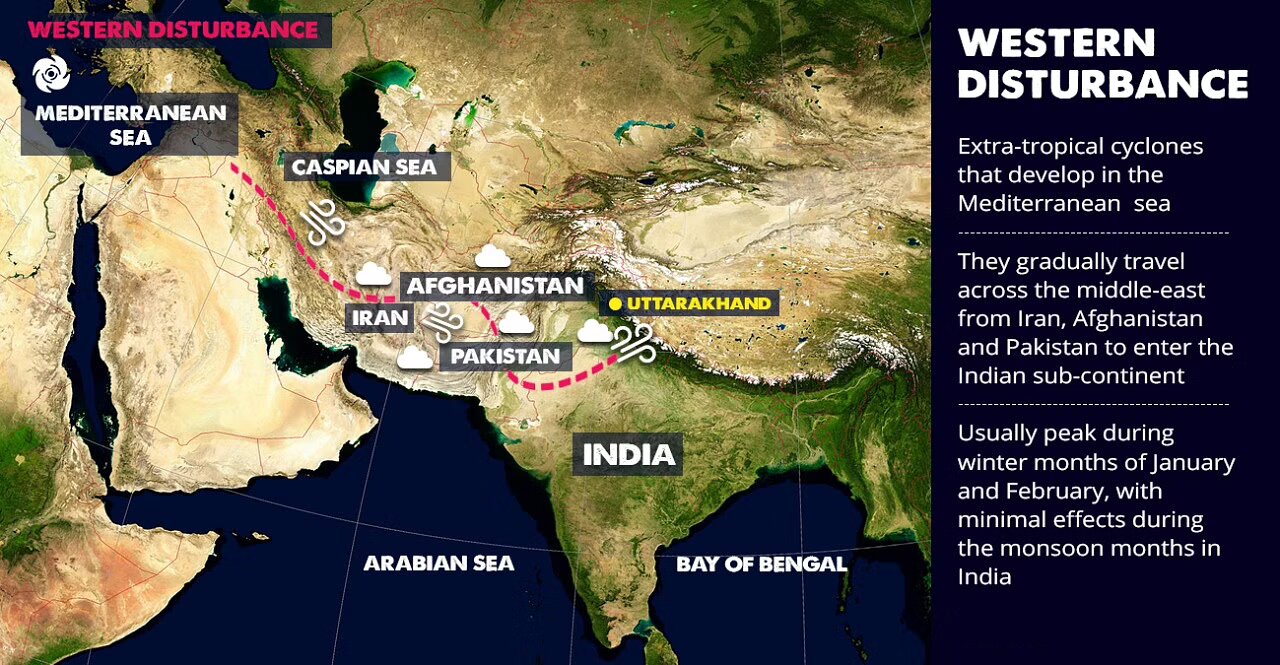Western Disturbances | 23 Apr 2022
For Prelims: Western Disturbances, Caspian Sea, Mediterranean Sea, India Meteorological Department, Flash Floods, landslides, Cold Wave
For Mains: Physical Geography, Western Disturbances and its Unusual Behavior
Why in News?
Variations in the intensity and locations of the Western Disturbances have brought heavy rainfall to Delhi during some months and kept the city dry and in the grip of a heat wave at other times.
What are Western Disturbances?
- Western disturbances are storms that originate in the Caspian or Mediterranean Sea, and bring non-monsoonal rainfall to northwest India, according to the India Meteorological Department (IMD).
- They are labelled as an extra-tropical storm originating in the Mediterranean, is an area of low pressure that brings sudden showers, snow and fog in northwest India.
- The meaning of WD lies in its name.
- The disturbance travels from the “western” to the eastern direction.
- These travel eastwards on high-altitude westerly jet streams - massive ribbons of fast winds traversing the earth from west to east.
- Disturbance means an area of “disturbed” or reduced air pressure.
- Equilibrium exists in nature due to which the air in a region tries to normalise its pressure.
- The disturbance travels from the “western” to the eastern direction.
- In the term “extra-tropical storm”, storm refers to low pressure. “Extra-tropical" means outside the tropics. As the WD originates outside the tropical region, the word “extra-tropical” has been associated with them.
- A WD is associated with rainfall, snowfall and fog in northern India. It arrives with rain and snow in Pakistan and northern India. The moisture which WDs carry with them comes from the Mediterranean Sea and/or from the Atlantic Ocean.
- WD brings winter and pre-monsoon rain and is important for the development of the Rabi crop in the Northern subcontinent.
- The WDs are not always the harbingers of good weather. Sometimes WDs can cause extreme weather events like floods, flash floods, landslides, dust storms, hail storms and cold waves killing people, destroying infrastructure and impacting livelihoods.
What is the Variation in Western Disturbances?
- In 2021, Delhi witnessed the rainiest October in 65 years, with the Safdarjung weather observatory recording 122.5 mm of rainfall against a normal of 28 mm, on account of western disturbances.
- Excess rainfall was also recorded in January and February this year. In contrast, there was no rainfall in November 2021 and March 2022, and the summer saw an unusually early start with heat waves setting in at the end of March 2022.
- Multiple western disturbances that brought cloud cover had also kept the maximum temperature low in February 2022, when the lowest maximum temperature in 19 years was recorded.
- Active western disturbances eluded northwest India in March 2022, and absence of cloud cover and rain allowed temperatures to remain high.
What is the Probable Cause of the Variation?
- The frequency of western disturbances has increased, but not the precipitation associated with them, partly due to a warming atmosphere (Global Warming).
- Western disturbances are low-pressure areas. If it is a feeble western disturbance, it will not have moisture to precipitate.
- For precipitation, you need moisture, and by virtue of a warming atmosphere, there is less amount of moisture available to precipitate.
- Simultaneously, because of warming in the atmosphere, western disturbances are going higher in elevation. In general, they move in subtropical westerly jet, now they are becoming lighter and moving higher, above 200 hectopascals.
- Variations will have to be monitored over the next few years to determine what climate change impact might be.

